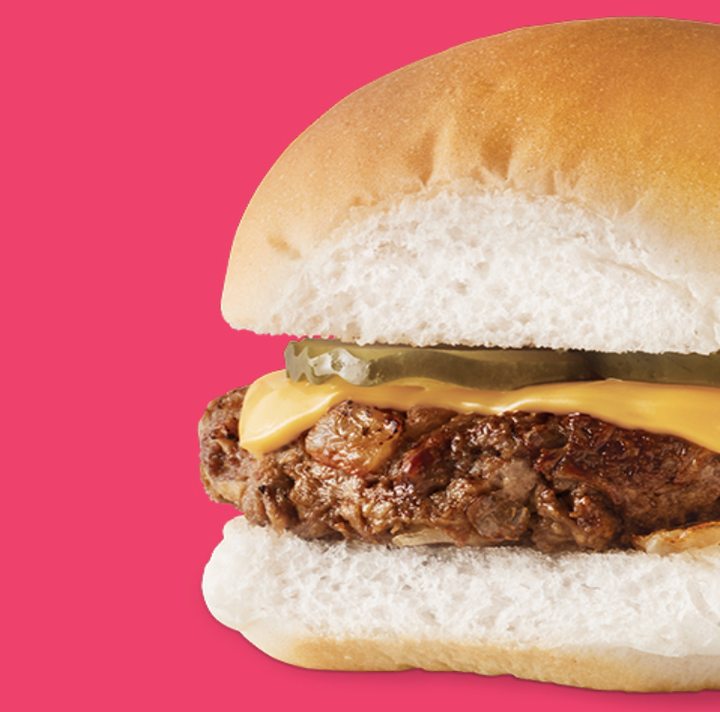There's something about a hamburger that can take over your mind in an instant. Upon a whiff of sizzling meat, the brain has a new primary objective: Get meat.
What is it that makes our minds go nuts for burgers? Maybe it's primal wiring that goes back tens of thousands of years, when we first started cooking meat over fire.
But personally, now that I'm in my thirties, the slightly more evolved part of my mind often asks the question, "Frankie, are you sure you want to eat that?"
There are three reasons I've begun to refrain (sometimes) from indulging in one of my favourite things.
The first is simple: I don't always feel great after I eat a beef burger. My state of being becomes sluggish and bloated, which is admittedly often a fair trade for the satisfaction of a hot, bloody, meaty flavour bomb.
The second reason is health. Meat is ubiquitous in the everyday Western diet, with meat consumption expected to hit an all-time high in 2018. The average American eats more than 100kg of meat a year, polluting our arteries as well as the environment. In other words, it's unsustainable.
(It should be noted, however, that giving up meat doesn't always translate into a "healthier" lifestyle. While 6 percent of the U.S. population now identifies as vegan ― versus 1 percent in 2014 ― that doesn't seem to be making any meaningful dent in the upward trend line of obesity.)
The third reason I occasionally abstain from eating meat is for the welfare of animals. It's easy to forget that 100 years ago, if you wanted meat, you'd have to go and kill the animal yourself. In today's world, the guilt has been completely removed.
So how are we supposed to satisfy a burger craving with all this guilt on our shoulders? Maybe ignorance is bliss, but ideally there's a better answer.
Enter 'fake meat'
Fake meat could be the answer, and there are two main players in the fake meat space that I like to call the "future food" movement: Impossible Foods and Beyond Meat.
Impossible's product ― it's known for looking and tasting just like real meat, blood and all ― is served exclusively in restaurants. It gained some popularity after being served at David Chang's Momofuku Nishi two years ago, which was when my mind was blown by the convincing aroma and "blood" dripping down my arm after the first bite. It's now served in more than 600 locations in 20 U.S. states.
Beyond Meat also attempts to mimic real beef, though perhaps slightly less convincingly. It got its start in grocery stores such as Whole Foods, selling its product in the meat case alongside the real thing, which is something the meat industry isn't too happy about. The brand has now also moved into restaurants.
Together, Impossible Foods and Beyond Meat have raised nearly $500-million (~R6.6-billion) to help spread the word and scale up their operations.
But seriously. What's this stuff made of?
Imagine a vegan burger patty that sizzles, smells and bleeds like the real thing, and that's what you've got. It's nothing like the grainy, seedy, beany imposters that veggie burgers of days past have been. But Impossible and Beyond burgers are both made entirely from plants.
Beyond Burgers are made primarily from pea protein and includes beet juice extract for colour.
The secret ingredient in the Impossible Burger, the one I find more convincing of the two, is a compound called heme, which is what carries oxygen in the blood of living things. It's what makes meat taste like meat, and the team at Impossible has figured out how to produce heme by using plants and a secret fermentation process.
An Impossible Burger representative told HuffPost in an email that their engineered heme is "identical to the essential heme humans have been consuming for hundreds of thousands of years in meat. And while it delivers all the craveable depth of beef, it uses far fewer resources."
And that is what's really exciting.
What's the environmental impact of fake meat?
These patties are much better for us and the planet. Pound for pound, Impossible Burger says it uses 75 percent less water, generates 87 percent fewer greenhouse gases and requires one-twentieth of the land required by beef from cows.
Even if you're not a mathematician, napkin calculations will tell you that if Impossible can get the economies of scale working in its favour, it could theoretically have a product that costs one-tenth that of beef. If these fake meats truly take off, fast-food chains will have no choice but to serve products like this down the line.
Beyond Meat's website touts that its mission also includes "positively impacting climate change, conserving natural resources and respecting animal welfare".
So how do I get my hands on one of these things?
Many independently owned restaurant across the country, even Saxon & Parole, a Michelin-starred New York eatery, serve Impossible Burgers on their menu.
But the biggest restaurant group selling this product by far is White Castle, America's oldest burger chain. You can pick up "The Impossible Slider" at 140 of its locations.

White Castle vice-president Jamie Richardson explained to HuffPost how this came to be. He said that two years ago, customers asked for more vegetarian options, so the company began selling Dr. Praeger's vegetarian patties.
"Impossible seemed like the next logical step," Richardson said, "plus it's a value proposition we're making to our cravers. Our Impossible Sliders are $1.99 a pop. We feel everyone should be able to try something new and no one else is serving at that price point. It's been a home run from the beginning."
While White Castle practically invented its industry in 1921 with the original slider, it's interesting to consider what a meatless future may bring. Businesses are always looking to reduce cost and increase efficiency, and serving meats like Impossible provides the potential to do both across the whole supply chain.
Impossible told us its mission is "to transform the global food system to support the planet and growing human population. Our goal is to replace animals as a food production technology by 2035. We aim to get the cost of the Impossible burger below the cost of meat from a cow as soon as possible, but it will require scaling the business to make that happen."
It will also require something that's better than the real thing.
Its success will depend on how convincingly delicious it is
You're going to have to try one. In my experience, Impossible and Beyond Burger taste better than low-end beef burgers by a mile. They're probably better than 80 percent of all burgers I've consumed.
However, Impossible isn't as satisfying as J.G. Melon or Shake Shack. But both Impossible and Beyond Burger acknowledge this and are continuing development to make their burgers even more competitive with meat.
Impossible told us that a blind taste test conducted in 2012 resulted in only 6 percent of the tasters preferring the faux meat. The latest test, however, produced a 48 percent preference for Impossible.
The graph is moving in the direction of making a power play in the industry. I'd invest now if they'd let me. Bill Gates already has.
Is this going to hurt the meat industry?
So is the future of meat meatless? White Castle says the future is a mix of meat and plant-based options and Impossible says the future is all plant-based. The truth could be somewhere in the middle.
Flavour is the final frontier. While a burger from J.G. Melon still tastes better than the Impossible burger, the majority of real burgers I've consumed in my lifetime weren't as flavourful and convincing, which is why you should try one of these meatless options.
Products like Impossible and Beyond Burger can help us reduce meat consumption in our over-populated world and potentially give you something delicious to love, too.
